US Li-Fi Market Size
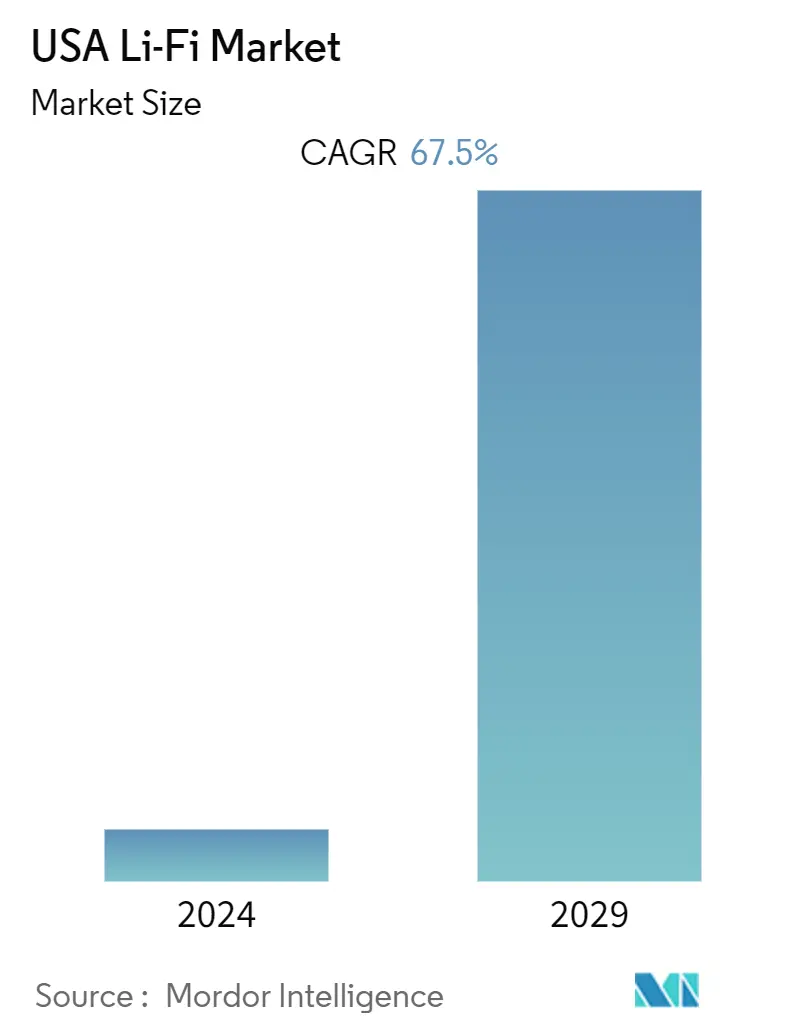
| Study Period | 2019 - 2029 |
| Base Year For Estimation | 2023 |
| Forecast Data Period | 2024 - 2029 |
| Historical Data Period | 2019 - 2022 |
| CAGR (2024 - 2029) | 67.50 % |
| Market Concentration | High |
Major Players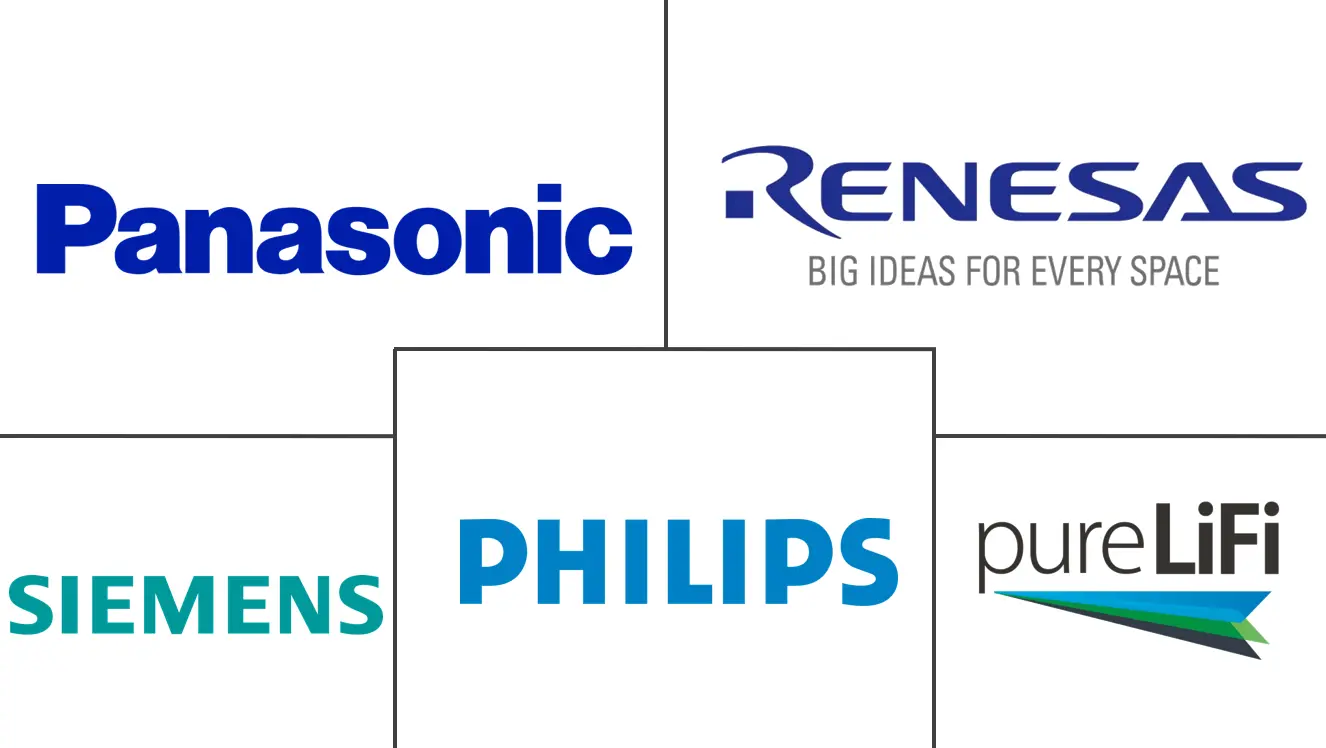
*Disclaimer: Major Players sorted in no particular order |
US Li-Fi Market Analysis
The USA Li-Fi Market is expected to register a CAGR of 67.5% during the forecast period.
The growing demand for high-speed networks and increasing demand for energy-efficient solutions are some of the major factors driving the adoption of Li-Fi technology in the United States.
- The growing number of smart devices and connected devices in the United States resulted in the generation of a massive amount of data, which is pushing the existing Wi-Fi, 4G, and other networking technologies to their limit. Therefore, Li-Fi technology can help overcome these issues by providing high-speed connectivity, additional bandwidth, and higher security benefits, thereby creating ample scope for growth for the market to grow throughout the forecast period.
- In the United States, the Li-Fi market is expected to grow exponentially, primarily in small to medium-sized homes, making it more innovative and efficient. Li-Fi can be installed in any house, commercial building, aircraft, street, and others. It has vast usage in the future and holds immense potential. Without any new arrangement, Li-Fi can be used from existing LED bulbs in houses. It can be installed in streetlights as well and can provide internet to each person walking on the streets. Moreover, instead of a Wi-Fi router, customers can install Li-Fi in their houses through LED bulbs and tubes, which saves energy and provides high-speed data with security, creating ample growth opportunities for the market to grow and expand throughout the forecast period.
- Additionally, the utilization of Li-Fi in marine and subsea applications is also manifold. For instance, the US Navy presently uses a slow and antiquated system for underwater communication that could be better with the poor acoustics that lie underwater. As a result, the US Navy is developing various advanced communication technologies using Li-Fi to counter the problem of subsea communication. Further, for use in petrochemical plants or on airplanes, Li-Fi emissions are considered to be a great solution since Wi-Fi tends to interfere with onboard electronics.
- However, physical barriers, such as walls and doors, limit the operational scope of Li-Fi-enabled LED light. Thus, the data transmitted by a Li-Fi product remains confined within a closed space because light cannot penetrate opaque objects and has a shorter range, limiting the market's overall growth rate.
- The COVID-19 pandemic severely impacted a broad spectrum of organizations' regular business operations across a range of industries. Hospitals and medical facilities, however, confronted a significant problem in treating patients because of the large surge in COVID-19 cases globally. However, during the post-COVID-19 market scenario, the market witnessed significant growth opportunities, primarily due to the rising demand for specialized internet technologies within the region.
US Li-Fi Market Trends
LED Segment is Expected to Register a Significant Growth Rate
- Smart buildings have begun adapting to accommodate their residents to improve the resident's comfort and user experience by knowing the locations of each occupant and then providing location-based services, such as logistics, intelligent car parking, health monitoring, and shopping assistance. In addition to indoor shopping assistance, location-based services are also playing a crucial role in the reduction of building energy costs. The primary idea of Li-Fi technology is to utilize the visible light from an LED light bulb to transmit high-speed data to a photodetector, which is connected to a smartphone or tablet.
- The rising growth in the usage of LED lamps in buildings for lighting also provides enormous opportunities for Li-Fi-based applications. As Li-Fi primarily combines the functions of high-speed wireless data communication and indoor lighting infrastructure, it is very cost-effective to be utilized in smart buildings. As long as they are in close proximity to a nearby LED lamp, smart building residents can easily get access to internet service without extra hardware costs (such as a Wi-Fi router or cables). When smart building residents walk inside a smart building, the indoor LED lighting will offer free wireless internet connection service.
- High illumination, long life, and low power consumption have led to the implementation of LED as a primary component in Li-Fi systems across the United States. The government's promotions for smart LED bulbs in the United States are expected to provide a massive infrastructure base for Visible Light Communication (VLC) system providers.
- Moreover, the growth and increase in the lifetime of LED lighting have led to the formation of new commercial prototypes in the lighting industry. In Li-Fi technology, visible light coming from LED bulbs acts as a carrier for data and can reach any devices that are illuminated by it. The flickering of the LED bulb creates a signal for the receiver device, thereby transmitting data. This wireless optical networking technology has the potential to transmit data up to a speed of 224 GB per second and is about 100 times faster than Wi-Fi.
- As per the US Department of Energy, LED lights are forecast to be gaining popularity at a drastic rate between 2020 and 2035 in the United States. By 2025, LED lights should be installed in 73% of residential lighting and become the most common light source in all sectors. This will create enormous growth opportunities for the market to grow and enhance throughout the forecast period, which in turn will drive the market significantly.
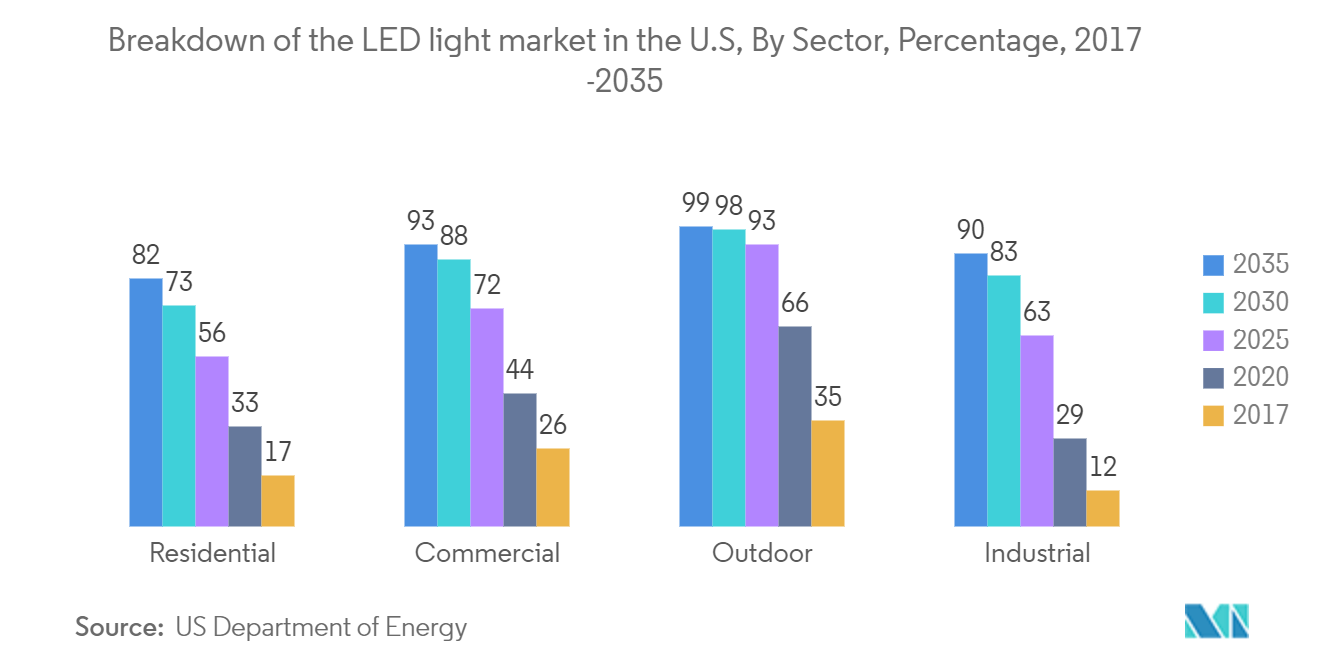
Rise in the internet usage and increasing applications of indoor location-based services in the United States is Expected to Drive the Market Growth
- The utilization of Li-Fi in marine and subsea applications is also manifold. For instance, the US Navy presently uses a slow and antiquated system for underwater communication that does not quite jibe well with the poor acoustics that lie underwater. As a result, the US Navy is developing advanced communication technology using Li-Fi to counter the problem of subsea communication. Further, for use in petrochemical plants or on airplanes, Li-Fi emissions are considered to be a great solution since Wi-Fi tends to interfere with onboard electronics.
- The future applications that the US government has in mind for Li-Fi could serve a much bigger purpose than just for underwater, airplane, and chemical plant usage. Presently, the Federal Communications Commission has explained cautions of crowding in wireless communications since the radio frequency spectrum is beginning to get full.
- Also, the increasing applications of indoor location-based services embedded with light fixtures in retail shops and hotels in the region are anticipated to be one of the vital factors driving the growth of the market in the region. Various companies, such as GE Lightings and ByteLight Inc., have been deploying VLC installations in supermarkets, which, in turn, is helping retailers to tie customers' shopping history by tracking their location details.
- As Internet connectivity is becoming a necessity in this century and people are looking for hassle-free, fast internet, the spread of Li-Fi in the United States is expected to grow steadily throughout the forecast period. The rapid advancements in information technology, such as wireless sensor networks, the Internet of Things (IoT), Big Data, and smartphones, have significantly resulted in the development of smart buildings in the region. The penetration of smart homes in the region is further expected to rise owing to the advancement in multiple technologies, thereby offering several opportunities for Li-Fi in the region.
- As per We Are Social, as of 2023, approximately 92 % of individuals in the United States accessed the internet, up from nearly 87% in 2012. The United States was one of the largest online markets worldwide, and in 2022, with an overall count of around 299 million internet users in the United States. With this significant rise in the overall count of internet users in the United States, the demand for Li-Fi systems will rise considerably within the region, driving the market exponentially.
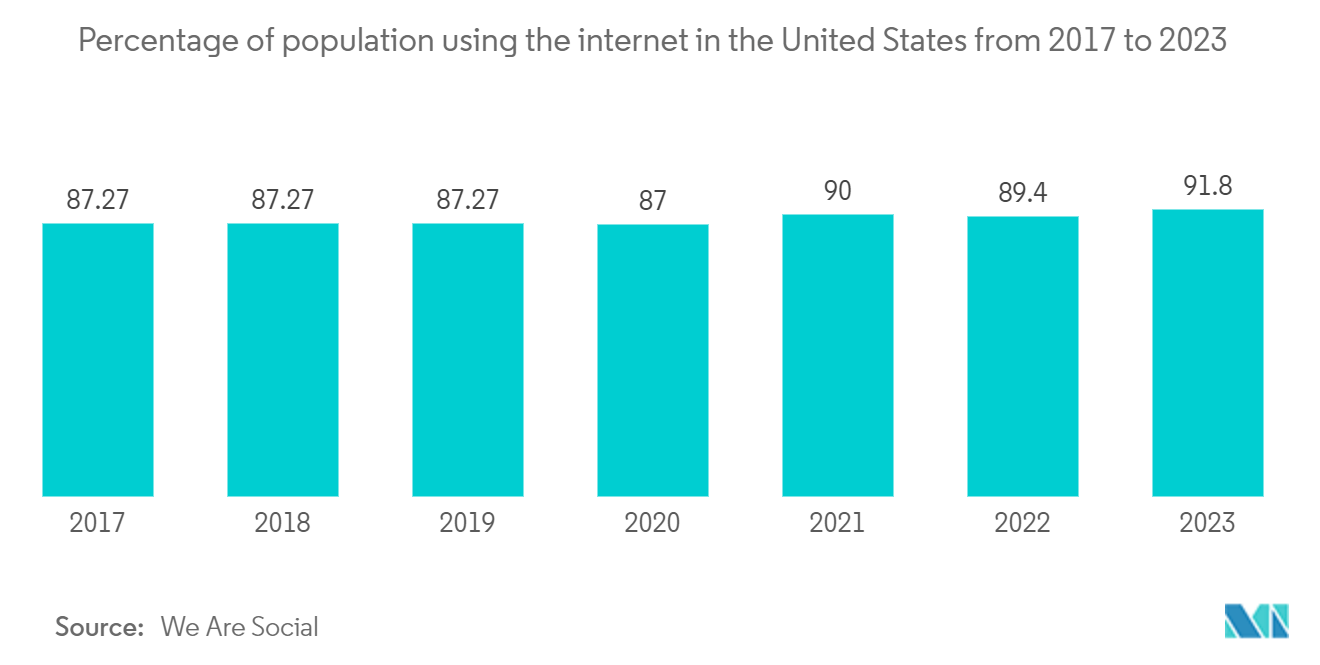
US Li-Fi Industry Overview
The vendor list is not provided as a part of the scope, but some of the major players operating in the industry include Panasonic, Philips, Renesas, Siemens, pureLifi, etc. These players do not have their headquarters in the United States but are well-positioned with multiple offices in the United States. The major players are increasingly seeking market expansion through various strategic mergers and acquisitions, innovation, and increasing investments in research and development.
- October 2023 - Nav Wireless Technologies, a pioneering force in Light Fidelity (LiFi) technology, launched 'Nav Ocular,' a groundbreaking device that leverages light to provide seamless internet connectivity within the comfort of the home.
- May 2023 - pureLiFi announced an agreement With Fairbanks Morse Defense to deploy secure LiFi technology. The collaboration with FMD represents a significant step towards expanding LiFi technology beyond pureLiFi's large-scale land-based deployments.
US Li-Fi Market Leaders
-
Panasonic Corporation
-
Koninklijke Philips NV
-
Renesas Electronics Corporation
-
Siemens AG
-
PureLiFi
*Disclaimer: Major Players sorted in no particular order
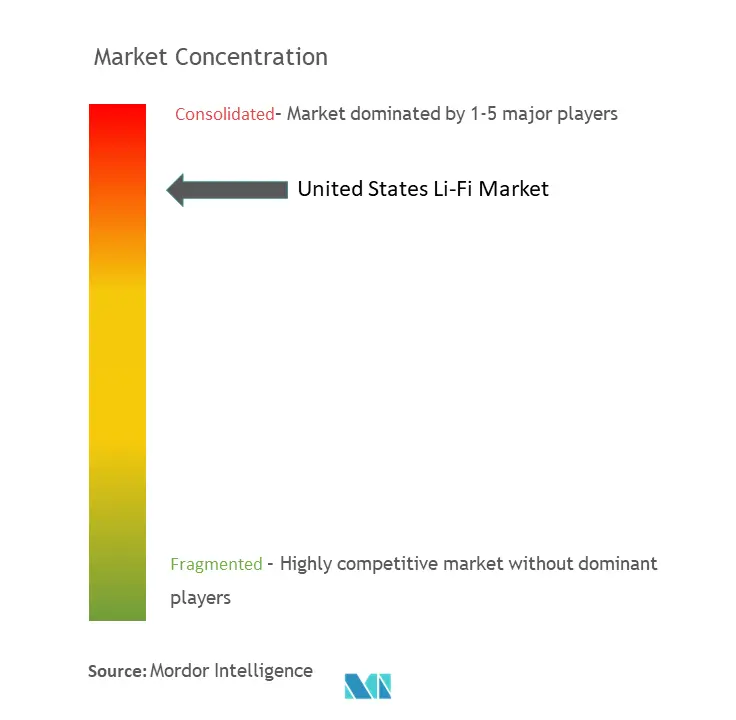
US Li-Fi Market News
- September 2023 - Getac announced it has embedded LiFi technology into rugged devices as part of an innovation project with Signify, one of the global leaders in lighting. Getac is working closely with Signify's Trulifi technology on the project to bring LiFi technology to its customers.
- April 2023 - Oledcomm, one of the global leaders in LiFi technology, internet through light, demonstrated new applications in space. After unveiling LIFIMAX2G, enabling future factories and transportation to connect through invisible light and doubling the connection speed to 2Gbps, .
US Li-Fi Market Report - Table of Contents
1. INTRODUCTION
- 1.1 Study Assumptions and Market Definition
- 1.2 Scope of the Study
2. RESEARCH METHODOLOGY
3. EXECUTIVE SUMMARY
4. MARKET INSIGHTS
- 4.1 Market Overview
- 4.2 Value Chain Analysis
-
4.3 Industry Attractiveness - Porter's Five Forces Analysis
- 4.3.1 Threat of New Entrants
- 4.3.2 Bargaining Power of Buyers
- 4.3.3 Bargaining Power of Suppliers
- 4.3.4 Threat of Substitutes
- 4.3.5 Intensity of Competitive Rivalry
- 4.4 Assessment of the Impact of COVID-19 on the Market
5. MARKET DYNAMICS
-
5.1 Market Drivers
- 5.1.1 Huge Demand for Specialized Internet Technologies
- 5.1.2 Low Energy Consumption
- 5.1.3 Faster and Safe Data Transfer
- 5.1.4 High Bandwidth
- 5.1.5 Vast Applications
-
5.2 Market Restraints
- 5.2.1 Limited Range
- 5.2.2 Cannot Substitute Wi-Fi Completely
- 5.2.3 Scattered Internet Penetration
- 5.2.4 Transmission can be Easily Disrupted
-
5.3 Market Opportunities
- 5.3.1 Smart Homes and Smart Cities
- 5.3.2 Offices Requiring High Speed Internet
- 5.3.3 Railways and Airlines
6. MARKET SEGMENTATION
-
6.1 Cities
- 6.1.1 New York
- 6.1.2 Los Angeles
- 6.1.3 Chicago
- 6.1.4 Houston
- 6.1.5 Philadelphia
- 6.1.6 Washington
- 6.1.7 Other Cities
-
6.2 Estimated Usage
- 6.2.1 House
- 6.2.2 Corporate Office
- 6.2.3 Railways and Airlines
- 6.2.4 Airways
- 6.2.5 Retail Stores/Supermarkets/Hypermarkets
- 6.2.6 Hotels
- 6.2.7 Others
-
6.3 Types
- 6.3.1 LED
- 6.3.2 Photodiodes
- 6.3.3 Microcontrollers
- 6.3.4 Other Types
7. INVESTMENT ANALYSIS
8. RECENT DEVELOPMENTS AND TRENDS
9. FUTURE OF THE MARKET
** Subject To AvailablityUS Li-Fi Industry Segmentation
Li-Fi is a wireless communication technology that uses the visible light spectrum or infrared spectrum for high-speed data communication. It offers significantly greater security and safety and ultra-fast data transmission rates to deliver unprecedented low latency and reliability. Li-Fi is a form of green communication method that salvages the existing lighting infrastructure for communication. The data is transmitted by varying the light intensity that is invisible to the human eye.
The United States Li-Fi market is segmented by cities (New York, Los Angeles, Chicago, Houston, Philadelphia, Washington, and Other Cities), estimated usage (house, corporate office, railways and airlines, airways, retail stores/supermarkets/hypermarkets, hotels, and other usages), types (led, photodiodes, microcontrollers, and other types). The market sizes and forecasts are provided in terms of value (USD ) for all the above segments.
| Cities | New York |
| Los Angeles | |
| Chicago | |
| Houston | |
| Philadelphia | |
| Washington | |
| Other Cities | |
| Estimated Usage | House |
| Corporate Office | |
| Railways and Airlines | |
| Airways | |
| Retail Stores/Supermarkets/Hypermarkets | |
| Hotels | |
| Others | |
| Types | LED |
| Photodiodes | |
| Microcontrollers | |
| Other Types |
US Li-Fi Market Research FAQs
What is the current USA Li-Fi Market size?
The USA Li-Fi Market is projected to register a CAGR of 67.5% during the forecast period (2024-2029)
Who are the key players in USA Li-Fi Market?
Panasonic Corporation, Koninklijke Philips NV, Renesas Electronics Corporation, Siemens AG and PureLiFi are the major companies operating in the USA Li-Fi Market.
What years does this USA Li-Fi Market cover?
The report covers the USA Li-Fi Market historical market size for years: 2019, 2020, 2021, 2022 and 2023. The report also forecasts the USA Li-Fi Market size for years: 2024, 2025, 2026, 2027, 2028 and 2029.
US LiFi Industry Report
Statistics for the 2024 US LiFi market share, size and revenue growth rate, created by Mordor Intelligence™ Industry Reports. US LiFi analysis includes a market forecast outlook 2029 and historical overview. Get a sample of this industry analysis as a free report PDF download.



